Artists share the process and inspirations behind their work.
By Linnea Jessup
Behind each artist and every painting, sculpture, and multimedia creation lies a fascinating story. Events, places, people and even something as simple as color or texture can inspire a work of art, and the stories behind a piece can help us gain a greater appreciation for its complexity and increase the effect it can have on us. The following artists generously shared their stories with ABN, allowing us exclusive access to their inspiration processes.
Travis Tarbox Hotaling
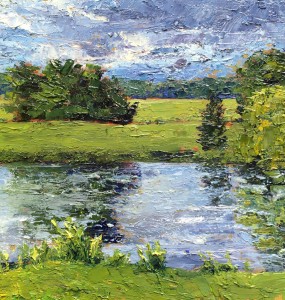 Travis Tarbox Hotaling, an artist who resides in the village of Yellow Springs, Ohio, begins each painting session by loading up his bicycle with supplies and pedaling off to discover his next inspirational location. Hotaling’s most recent series of paintings features plein-air landscapes of the environment around his hometown, many of which are unmarred by human development—that is, they have few buildings or distinctive manmade barriers. However, as Hotaling points out, viewers can still feel human presence in his landscapes because agricultural farming has given character to even the remote fields of the rural Ohio that he paints.
Travis Tarbox Hotaling, an artist who resides in the village of Yellow Springs, Ohio, begins each painting session by loading up his bicycle with supplies and pedaling off to discover his next inspirational location. Hotaling’s most recent series of paintings features plein-air landscapes of the environment around his hometown, many of which are unmarred by human development—that is, they have few buildings or distinctive manmade barriers. However, as Hotaling points out, viewers can still feel human presence in his landscapes because agricultural farming has given character to even the remote fields of the rural Ohio that he paints.
The conditions of nature provide a welcome challenge for the artist. “Sometimes I’ll do little sketches, but often I am eager just to throw a panel up on the easel and start finding shapes,” he says. “Speed becomes necessary to find certain light effects or weather patterns.”
But the overall effect of painting outside in remote pastoral landscapes has been meditative and calm. “To sit relatively still in a single location as [nature] moves around you can have a profound effect on the perception of the speed at which we live our lives,” he says.
In his plein-air series, Hotaling has begun using palette knives to add a sculptural element to his paintings. “Using the knives is a new experience for me,” he says. “I’ve greatly enjoyed being able to work with the textures and layers they create.”
As winter settled in on Yellow Springs, Hotaling has moved his work indoors but continues to add to the series by translating some of the pieces he painted outdoors, which are often small due to the limited carrying capacity of the bicycle, into larger-scale works.
In the future, Hotaling says, he’d like to take his bike and his paints overseas to bike and paint across foreign continents. “It’s always exciting to step into unknown territory and see where it will take you as an artist,” he says. “That’s the only way to maintain an art career—to never stop looking for something new to try. When it comes to art-making, there is no pinnacle—no finish line. There is always something new to attempt or an advancement to make in your observations, aesthetic, effort or execution. It is a lifelong pursuit if you want it to be.”
In Leda Maria’s creations, she works with watercolors, oils, acrylics, mixed media and encaustic. No matter the medium, though, color provides the first inspiration for many of her artworks. Her painting “I Like Blue, but I Prefer Red” kicked off the “Red” series of paintings she’s been working on since 2005.
In the Red series, she uses foam, natural fabrics, rocks and other materials to add texture. “Red is my favorite color,” she says. “It comes from the heart. When I started the series, I had the color and subject in mind and just kept composing until I was done.”
Maria says that she also gets inspiration from people whom she observes while traveling. Some of the paintings from the series were displayed at the Show de Bola exhibition last year in Brazil, which Maria curated. Each painting was in the shape of a hexagon to symbolize the earth, or a patchwork of the world.
Maria calls the Show de Bola exhibit a “social-cultural project” and notes that artists of all ages, backgrounds and styles can participate. “For many artists, it is their first time to be in an organized show,” she says.
In this year’s Show de Bola, artists will be encouraged to share the beauty of their own countries in their art submissions. The show is being expanded this year and will be part of Artexpo New York and the Berlin Art Fair, both in April. In addition, Maria has been invited to participate in the Venice Biennale, which opens in May.
Born in Brazil, Maria currently lives in New York.
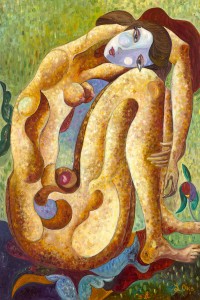 Leon Oks
Leon Oks
Vibrant colors fill Leon Oks’ canvases of landscapes, women and images from his childhood in Ukraine. Inspired by Claude Monet and Marc Chagall, among others, Oks notes that nearly every one of his creations reflects a “feminine life force.”
“I focus on women—the power and strength of women,” he says. “My mother, widowed during World War II, inspired my respect for women. Women are so strong; they are the structure of the family.”
Oks recalls that, many decades ago at age 23, he painted an orchard scene and for the first time included in his work images of the bodies and faces of women. His teacher at the time encouraged him to do a series for an exhibit, and the theme has continued through all of his work to date. “Even my paintings of other topics reflect women’s shapes,” he observes.
A strong sense of color led Oks to mix his own vibrant paint colors, which in turn give his paintings added dramatic effect.
Oks holds a degree in drafting and architecture and is also a musician. He immigrated to the United States from
Soviet-controlled Ukraine in 1980. “I wanted to be free to express myself,” he says. In Ukraine, his conservative professors discouraged his unique style and sensuous content, but in the United States, he came into his own as an artist.
Now living in Illinois, where he teaches and continues to create art, Oks loves the freedom of expression that painting encourages. “As an art instructor, I tell my students to develop their own individuality. Admire the masters, but you must have your own style.”
Oks’ work has been exhibited in museums and galleries throughout the world.
A move from Ontario, Canada, to Germany gave James Paterson the space and time to develop an artistic outlet. While serving as a dorm parent at the Black Forest Academy, a school in Germany for the children of international Christian workers and international business families who want a North American curriculum that incorporates a Christian worldview, Paterson began to think about prayer and what a prayer might look like if it had a physical shape.
The result of that train of thought was Paterson’s Prayer Machines, drawing-like sculptural pieces that combine whimsical and symbolic shapes. He describes his sculpture as “the simplest form of line drawing with pen and ink, except that [it’s] three-dimensional.”
The artist, who previously painted in a variety of styles—including realism, expressionism and retro pop—suddenly found himself in uncharted territory.
“In going to Europe and physically leaving everything behind, it felt like the slate had been wiped clean and something totally new had room to emerge,” he says.
After three years in Europe, Paterson and his wife moved back to Canada, this time settling in the Georgian Bay region. He credits the isolation and the peace of the rural area with giving him the time and space to develop his sculptural series, which he’s been showing now for three years.
“I now realize that all of my previous work was a lead-up to and a way to get to this body of work,” he says. “It is like many small yet diverse streams eventually flowing into one river.
“I would encourage other artists who believe they have a particular vision within them and are serious about wanting to find their true voice in their art not to give up,” he adds. “Face the obstacles in front of you head-on. Set goals and define what it will take to reach those goals; then work hard, believe in your vision and go for it.”
When creating portraits of renowned singers, Ben Riley goes to the source for inspiration—vinyl records. Shards of black vinyl, sometimes enhanced with other everyday items, such as buttons, give an edgy representation of those entertainers who are often larger than life in fans’ eyes.
A recent addition to Riley’s body of work was “Imagine,” a portrait of John Lennon, which Riley says was “inspired by the love, imagination and feeling that John Lennon gave to the world, which touched so many people and still does to this day.” “Imagine” evokes the iconic voice and personality known to generations of music lovers. “I wanted to create pieces that show more than just a good likeness. I wanted to get a lot more up close and personal to the subject,” explains the artist, who lives in England’s Staffordshire region.
“I chose to experiment with nothing but old, scratched, broken records. These records would have been cast aside, thrown away or sent to charity shops. I like to think that I am upcycling and immortalizing them into pieces of art for everyone to see.”
He uses some of the records in large pieces and grinds others into a powder, which he then applies over an adhesive to create the more intricate parts of an image. In some cases, the shards have still-attached record labels, adding flashes of color to the mostly black images.
Riley took more than two years to fine-tune the process of turning records into images. He says his biggest challenge was creating the facial features, expressions and details that other artists usually depict with paint, charcoal and pencils. But the finished product validates all of Riley’s hard work. “The result shows not only the likeness, but the soul, character and passion, true to the subject,” he says.
This new art form has changed Riley’s perspective. “I have learned to think outside the box and generally think more about my subjects and how to put their purpose and meaning into a piece. Art to me is all about experimenting; your first job is to dismantle the barriers that society and the media put around you. Let your mind venture out and be free.”
Anna Sweet describes her artwork—photographic images of women in an underwater setting—as a science, demanding precise and innovative techniques. Her images depend on precisely applying a photo image to metal; embedding minerals, crystals and glowing pigments in resin; and then applying this mixture onto the print.
“I’ve ruined many expensive prints in my studio trying to get the curing process just right,” she says.
One of Sweet’s images, “Naia,” reflects not only the artist’s self-imposed demand for absolute accuracy in materials applications but also her eye for photographic composition. Capturing the flowing fabric on a woman in an underwater chamber, Sweet creates an image that gives viewers the sensation of immersion.
“A weightless portrait of a woman falling into an abyss” is how she describes her images, which are part of a growing portfolio. “The 12-foot-deep infinity saltwater pool overlooking the Pacific was just the studio I longed for,” says Sweet of the shooting location of this image.
“I wanted to evoke emotions of complete joy and levity … embedding textures to bring each image to life,” she says.
Sweet began her photography career in fashion, but she felt as though she were “on a treadmill.” Once she embarked on her own creative path, it took her two years to get her first piece in a gallery, but she persevered. “I wanted to do something truly unique, something I could sculpt with my hands, not just my mind,” she says.
In this quest, the Key West, Florida, resident has traveled around the world, taking photos in various bodies of water and researching new galleries. “I’m obsessed with wowing my collectors with new and creative ideas and works,” she says.
Each new print begins with a hand-picked model. “Beauty to me is something that’s strictly multidimensional,” says Sweet. “Getting to know someone is the best way to decide if they’re beautiful and the type of person I want to photograph. I don’t use professional models.”
Peter Terrin’s oversized portraits, which are electric with color, grab the attention of the viewer and graphically reveal emotion. The Belgian artist currently lives in Mexico but travels extensively; he uses his artwork to draw viewers into the situations of people from around the world.
Terrin’s Kayapo Series, which he created last year, was inspired by a January 2014 National Geographic article about the Kayapo people of Brazil. The Kayapo live in the eastern part of the Amazon rainforest and fight relentlessly to preserve the forest and their tribal traditions.
“I was immediately moved to do whatever I could to raise awareness of these people, who are fighting to protect the fragile rainforest—the lungs of planet Earth,” Terrin says.
“Using only palette knives, acrylic paint and canvas, I started on a journey of creating 10 large-scale portraits using the authorized work of National Geographic photographers Cristina Mittermeier and Martin Schoeller, along with renowned environmental photographer Art Wolfe.”
Proceeds of Terrin’s work will be donated to the Kayapo tribe, which continues to struggle to defend its land and way of life.
Terrin says his style has been referred to as “modern pointillism”: bold strokes that appear abstract when viewed up close and come into focus only when the viewer steps away from the canvas.
“The challenge is always capturing the character of my subjects. Working on this series was an emotional experience, as their struggles, strength, innocence and hope were so clearly evident in their eyes and etched on their stoic faces,” he says.
Terrin advises artists to always believe in themselves and keep working on developing their own style and technique. “[Art] requires passion, determination and discipline. The key to success is to practice every day. Keep an open mind and a positive attitude.”


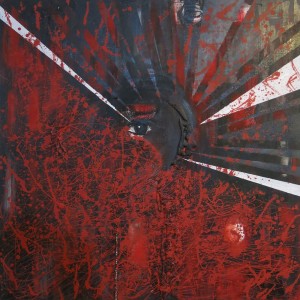


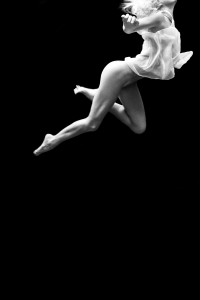
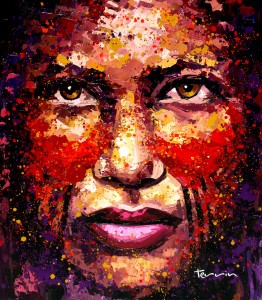





NO COMMENT